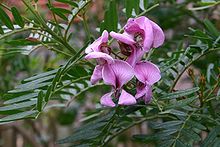
Petteria ramentacea, commonly known as Dalmatian laburnum, is a species of flowering plant in the family Fabaceae. It is a deciduous shrub native to the western Balkan Peninsula, including Greece, Albania, Bosnia and Herzegovina, and Montenegro. It grows up to 3 meters tall, and flowers in May. It grow in shrubland and scrub from 10 to 700 meters elevation, in both sub-Mediterranean and Mediterranean habitats. It belongs to the subfamily Faboideae. It is the only member of the genus Petteria.

Argyrocytisus battandieri, the pineapple broom or Moroccan broom is a species of flowering plant in the legume family, Fabaceae, subfamily Faboideae. It is the only member of the genus Argyrocytisus.
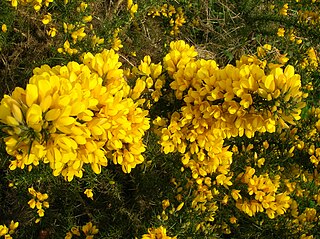
Ulex is a genus of flowering plants in the family Fabaceae. The genus comprises about 20 species of thorny evergreen shrubs in the subfamily Faboideae of the pea family Fabaceae. The species are native to parts of western Europe and northwest Africa, with the majority of species in Iberia.

Cassia is a genus of flowering plants in the legume family, Fabaceae, and the subfamily Caesalpinioideae. Species are known commonly as cassias. The genus includes 37 species and has a pantropical distribution. Species of the genera Senna and Chamaecrista were previously included in Cassia. Cassia now generally includes the largest species of the legume subtribe Cassiinae, usually mid-sized to tall trees.

Cyamopsis is a genus of the family Fabaceae. Its species are distributed across sub-Saharan Africa, Saudi Arabia, Pakistan, and India. Typical habitats include tropical seasonally-dry thorn scrub and grassland, often in floodplains, stream beds, and pans, and in open sandy or rocky areas.

Xanthocercis is a tree genus in the family Fabaceae. It includes three species native to sub-Saharan Africa.

Spartium junceum, known as Spanish broom, rush broom, or weaver's broom, it is a species of flowering plant in the family Fabaceae and the sole species in the genus Spartium. It is closely related to the other brooms.

Dipteryx is a genus containing a number of species of large trees and possibly shrubs. It belongs to the "papilionoid" subfamily – Faboideae – of the family Fabaceae. This genus is native to South and Central America and the Caribbean. Formerly, the related genus Taralea was included in Dipteryx.
Haplormosia is a monotypic genus of legumes in the family Fabaceae. Its only species is Haplormosia monophylla, commonly known as Liberian black gum, native to Cameroon, Ivory Coast, Liberia, Nigeria, and Sierra Leone. It is threatened by habitat loss.

Barklya is a genus of Australian trees in the legume family, Fabaceae. It belongs to the subfamily Cercidoideae. The sole species is Barklya syringifolia, commonly known as golden crown or golden glory. It grows in rainforest to 20 metres tall. Recorded from Queensland and New South Wales in rain forest. It is often used as an ornamental.

Bolusanthus speciosus is a species of flowering plants in the family Fabaceae. It belongs to the subfamily Faboideae. It is the only member of the genus Bolusanthus.
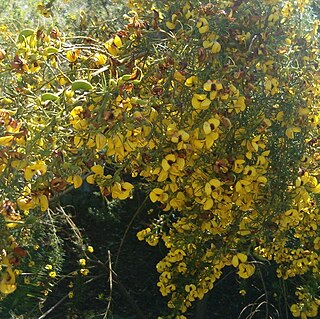
Cyclopia, the honeybush, or heuningbos in Afrikaans, is a genus of some 20 species of flowering plants in the legume family Fabaceae, subfamily Faboideae. Species of the genus are native to the southern and southwestern Cape Provinces of South Africa.

Hypocalyptus is a genus of flowering plants in the family Fabaceae. It includes three species of shrubs, subshrubs or small trees native to the Cape region of South Africa. Typical habitats include Mediterranean-climate shrubland (fynbos) at forest margins, in rocky and sandy areas, and along streams, often at high elevations.
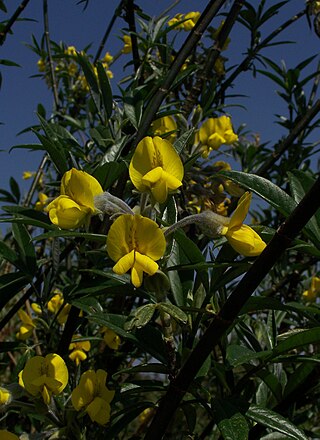
Piptanthus is a genus of flowering plants in the legume family, Fabaceae. It includes two species of shrubs native to the Himalayas, Tibet, Myanmar, and western China. They grow in montane grassland, thicket, and forest margins.

Podalyria is a genus of flowering plants in the family Fabaceae. It includes 17 species of small trees or shrubs native to the Cape Provinces, Free State, and KwaZulu-Natal in South Africa. They inhabit Mediterranean-climate shrubland from low to high elevations, typically in rocky or sandy areas. It belongs to the subfamily Faboideae. The genus is endemic to South Africa.

Vatairea is a genus of flowering plants in the legume family, Fabaceae. It includes eight species of tall trees native to the tropical Americas, ranging from southern Mexico to Bolivia and southern Brazil. Seven species are native to northern South America, with the center of diversity in Amazonia. Vatairea lundellii ranges from southern Mexico to Panama. Most species grow in tropical rain forest, often in the inudated forests known as igapó and varzea, where they are emergent trees, growing above the forest canopy. V. macrocarpa grows in seasonally-dry forest, cerrado, and caatinga.
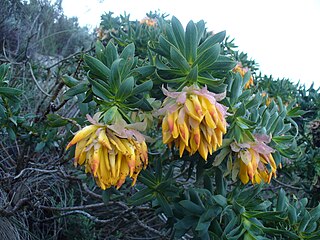
Liparia is a genus of flowering plants in the legume family, Fabaceae. It includes 20 species native to the Cape Provinces of South Africa. It belongs to the subfamily Faboideae.
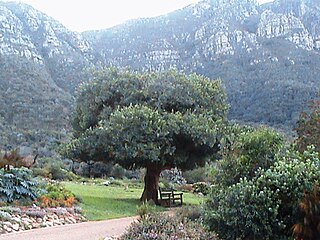
Maytenus oleoides, commonly known as the mountain maytenus or rock false candlewood, is a dense, medium-sized tree that grows throughout the western half of South Africa. It is known as klipkershout in Afrikaans.

Cytisus nigricans, the black broom, is a species of flowering plant in the subfamily Faboideae of the family Fabaceae. Growing 3–5 ft (0.91–1.52 m) tall, it is a slender deciduous shrub with erect branches. Masses of brilliant yellow, slightly fragrant pea-like flowers appear in long racemes on the current year's growth in summer and early autumn.

Genisteae is a tribe of trees, shrubs and herbaceous plants in the subfamily Faboideae of the family Fabaceae. It includes a number of well-known plants including broom, lupine (lupin), gorse and laburnum.
